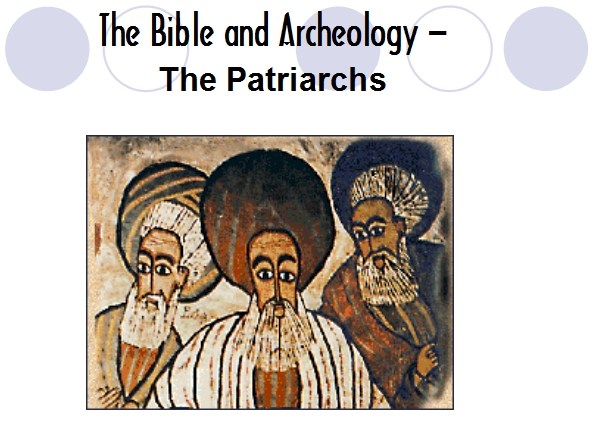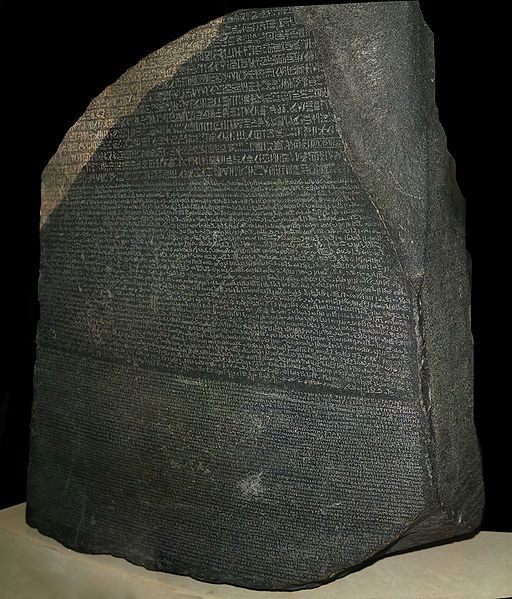|
DPS Biblical
Archeology Study Outline
5. The Patriarchs
|

Download: Teacher's Script: (PDF)
(Word) |
Handout: (PDF) (Word) |
PowerPoint
Overview
a. Inscriptions and Writings:
The Rosetta Stone
b. Abraham and his family
Discussion Questions
a. Inscriptions and Writings:
The Rosetta Stone

is an
ancient Egyptian
granite
stele
inscribed
with a
decree
issued at
Memphis
in 196 BCE on behalf of King
Ptolemy V.
The decree appears in three scripts: the upper text is
Ancient Egyptian
hieroglyphs,
the middle portion
Demotic
script, and the lowest
Ancient Greek.
Because it presents essentially the same text in all three scripts (with
some minor differences between them), it provided the key to the modern
understanding of
Egyptian hieroglyphs.
Originally
displayed within a
temple,
the stele was probably moved during the
early Christian
or
medieval period
and eventually used as building material in the construction of
Fort Julien
near the town of
Rashid
(Rosetta) in the
Nile Delta.
It was rediscovered there in 1799 by a soldier, Pierre-Francois
Bouchard, of the
French expedition to Egypt.
Inscriptions from a culture furnish the most objective information.
Further, they preserve for us what cannot be seen in artifacts, such as
history of the nation.
Abraham
and his Family
Abram, or as he is later called, Abraham, is seen in history as the
father of both the Jews and the Arab nations. Judaism, Christianity and
Islam hold him up as a spiritual leader.
The Family of Abram.
And Haran died in the presence of his father Terah in the land of his
birth, in Ur of the Chaldeans.
And Abram and Nahor took wives for themselves. The name of Abram’s wife
was Sarai; and the name of Nahor’s wife was Milcah, the daughter of
Haran, the father of Milah and Iscah. (Genesis 11:28-29)
The laws of incest in that day were not nearly so strict as they are
today. It was considered commonplace for an uncle to marry his niece.
The family tree of Abram looks like this.
In
the case of Laban, the nephew of Abram and the uncle of Jacob, the most
that we can say is that he considered Yahweh to be one of many tribal
gods. Only in Abram do we find a man who worshiped Yahweh exclusively.
THE LAND OF CANAAN
And Abram took Sarai his wife and Lot his nephew, and all their
possessions which they had accumulated, and the persons which they had
acquired in Haran, and they set out for the land of Canaan; thus they
came to the land of Canaan. (Genesis 12:5).
If
Haran is the hub of the wheel, then Canaan is one of the major spokes of
that wheel. The land of Canaan acts as a narrow land-bridge between
Mesopotamia and the continent of Africa.
This is a relatively small area of land, no larger in area than Lake
Erie or the state of Maryland. The name Palestine takes its name from
the ancient name Peleset, meaning “land of the Philistines.”
ABRAHAM IN CANAAN
As
Abraham first entered the land of Canaan, he traveled down the Central
Mountain Ridge to the site of the ancient town of Shechem.
And Abram passed through the land as far as the site of Shechem, to the
oak of Moreh. Now the Canaanite was then in the land.” (Genesis 12:6).
The town of Shechem would later be built in the pass that runs between
Mount Ebal and Mount Gerizim. It would be on this site that Jesus would
later hold an afternoon discussion with a woman by the well.
When the Scriptures says that the Canaanite was then in the land,
it is a reminder that the land of Canaan was not some uninhabited
wilderness. It was a land of cities and towns, of merchants and farmers
and shepherds.
Abraham came into this land as a nomadic shepherd-merchant. He did not
take up residence in any of the Canaanite cities, but remained a pilgrim
and a nomad. His sojourn seems to have been seasonal at times, especially in times
of famine.
ABRAHAM IN EGYPT
Now there was a famine in the land; so Abram went down to Egypt to
sojourn there, for the famine was severe in the land. (Genesis 12:10).
Upon finding a famine in the land of Canaan, Abraham moved his family
south to Egypt. The pyramids and the Great Sphinx were already hundreds
of years old as Abraham entered Egypt.
This was the First Intermediate Period of Egypt’s history. It was a time
of disunity as Egypt was broken up into several small feudal kingdoms,
each attempting to gain power over its neighbor. During this period, it
was not uncommon for foreigners to be permitted entrance into the
country.
While Abraham is in Egypt, he falls into danger. Fearful of his life, he
plots with his wife, Sarai, to pretend that she is his sister.
The reason for this deception is understood when we examine an Egyptian
papyrus which records a pharaoh murdering the husband of a beautiful
woman so that he could marry her.
SODOM & GOMORRAH
Upon returning to Canaan, Abraham has a falling out with his nephew,
Lot. They go their separate ways and Lot moves down to the southern part
of the Jordan Valley.
And Lot lifted up his eyes and saw all the valley of the Jordan, that it
was well watered everywhere – this was before the Lord destroyed Sodom
and Gomorrah – like the garden of the Lord, like the land of Egypt as
you go to Zoar. (Genesis 13:10}.
The implication of this and other passages of the Bible is that the area
of the Dead Sea was not the desolate wasteland that it is today. In that
day, it was a fertile land.
Genesis 14 records the military campaign of an alliance of kings from
the east.
o
Amraphel, king of Shinar. Shinar was the general term for Mesopotamia.
This may have been an Akkadian king.
o
Arioch, king of Ellasar: Ellasar was another name of Larsa, a Sumerian
city to the east of Ur.
o
Chedorlaomer, king of Elam: The Elamites were located to the east of
Sumer and were one of the most powerful countries in the world at this
time.
o
Tidal, king of Goiim: “Goyim” is the Hebrew word for “nations.” Tidal,
on the other hand, is a Hittite name and might reflect an early Hittite
alliance.
A
coalition of these kings from the east invaded Canaan, conquering the
cities of the Jordan Valley, and taking Abraham’s nephew, Lot, in the
process.
Abraham gathered his own alliance of Canaanite chieftains and set out in
pursuit, catching the invaders in a pincer movement in what is the first
night attack recorded in history. Lot was rescued along with the spoils
of the kings of the Jordan Valley. However, this served as only a
temporary respite for the cities of the plain.
Sodom was the major city of the Jordan Valley in the days of Abraham. It
was a beautiful, well-watered area. It had been for this reason that Lot
had chosen to live there.
The Dead Sea today in the lowest spot on the face of the earth. The
north part of the Sea is 1300 feet deep. Today the southern part has
dried up completely. Scholars generally place the location of Sodom and
Gomorrah in what is today this shallow, southern part of the Dead Sea.
Some distance from the shore and clearly visible under the surface of
the water, are stretched the outlines of forests which the
extraordinarily high salt content of the Dead Sea has kept in
preservation.
(Werner Keller, The Bible as History, pg 56).
The Bible records that Lord destroyed both these cities and everything
else in the Valley.
Then the Lord rained on Sodom and Gomorrah brimstone and fire from the
Lord out of heaven, 25 and He overthrew those cities, and all the
valley, and all the inhabitants of the cities and what grew on the
ground. (Genesis 19:24-25).
Confirmation
from Archaeology.
A
Phoenician inscription had this to say about the destruction of the
“Vale of Sidimus.”
The Vale of Sidimus sank and became a lake, always evaporating and
containing no fish, a symbol of vengeance and of death for the
transgressor. (Attributed to Sanchuniathon, prior to the Trojan War).
This indicates that there was a time when the Dead Sea was not there and
when the Jordan Valley was unbroken.
Confirmation
from Geology.
Genesis 14:10 says that the valley was full of “tar pits.” Petroleum and
asphalt deposits still exist around the Dead Sea today. It is a
burnt-out region where nothing grows.
We
have already mentioned that this area holds a massive fault zone.
Throughout its history, it has been the scene of many severe
earthquakes. It is possible that an earthquake combined with the
explosive petroleum and asphalt deposits to cause a great explosion of
“brimstone and fire.”
OTHER ARCHAEOLOGICAL NOTES FROM ABRAHAM’S DAY
1.
Lot’s Door.
In
Genesis 19:6, 9-10 we find several mentions of the door to Lot’s house
in Sodom. It is described in terms of having been shut to keep out the
men of Sodom.
Houses within cities did not always have doors in antiquity. A door
would interfere with any cool breeze, making the heat of the land
intolerable. Archaeologists have noted that there are different styles
of doors for differing eras
|
Middle Bronze (2200-1600 B.C.) |
Strong, sturdy wooden doors |
No strong, centralized government |
|
Early Iron II (800-600 B.C.) |
Doorways consisted of archways and curtains |
Kings of Judah and Israel provided centralized government |
The smaller the police force, the greater the need for a stout wooden
door.
2.
Abraham’s Purchase of a Tomb.
In
Genesis 23:16 we read that Abraham paid 400 shekels of silver. While
today a shekel is a form of currency, in that day it was a weight
designation. We think in terms of pounds or kilograms, they weighed in
terms of shekels. It was not until around 700 B.C. that money began to
be coined.
Discussion Questions:
In
your view, were Abraham and Sarah historical persons? Would it affect
your faith if they were part of a “patriarchal legend?” Do you find the
archeological. geological and historical confirmations convincing? Do you
believe God used the natural processes described above to allow Sodom
and Gomorrah to be destroyed?
|